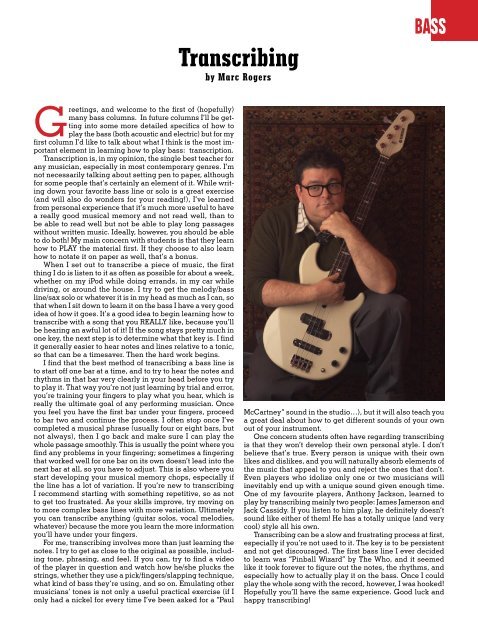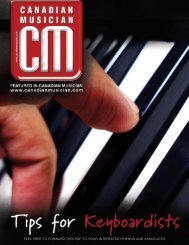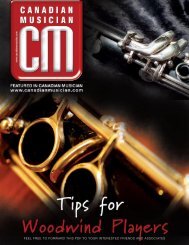Create successful ePaper yourself
Turn your PDF publications into a flip-book with our unique Google optimized e-Paper software.
Transcribingby Marc RogersBassGreetings, and welcome to the first of (hopefully)many bass columns. In future columns I’ll be gettinginto some more detailed specifics of how toplay the bass (both acoustic and electric) but for myfirst column I’d like to talk about what I think is the most importantelement in learning how to play bass: transcription.Transcription is, in my opinion, the single best teacher forany musician, especially in most contemporary genres. I’mnot necessarily talking about setting pen to paper, althoughfor some people that’s certainly an element of it. While writingdown your favorite bass line or solo is a great exercise(and will also do wonders for your reading!), I’ve learnedfrom personal experience that it’s much more useful to havea really good musical memory and not read well, than tobe able to read well but not be able to play long passageswithout written music. Ideally, however, you should be ableto do both! My main concern with students is that they learnhow to PLAY the material first. If they choose to also learnhow to notate it on paper as well, that’s a bonus.When I set out to transcribe a piece of music, the firstthing I do is listen to it as often as possible for about a week,whether on my iPod while doing errands, in my car whiledriving, or around the house. I try to get the melody/bassline/sax solo or whatever it is in my head as much as I can, sothat when I sit down to learn it on the bass I have a very goodidea of how it goes. It’s a good idea to begin learning how totranscribe with a song that you REALLY like, because you’llbe hearing an awful lot of it! If the song stays pretty much inone key, the next step is to determine what that key is. I findit generally easier to hear notes and lines relative to a tonic,so that can be a timesaver. Then the hard work begins.I find that the best method of transcribing a bass line isto start off one bar at a time, and to try to hear the notes andrhythms in that bar very clearly in your head before you tryto play it. That way you’re not just learning by trial and error,you’re training your fingers to play what you hear, which isreally the ultimate goal of any performing musician. Onceyou feel you have the first bar under your fingers, proceedto bar two and continue the process. I often stop once I’vecompleted a musical phrase (usually four or eight bars, butnot always), then I go back and make sure I can play thewhole passage smoothly. This is usually the point where youfind any problems in your fingering; sometimes a fingeringthat worked well for one bar on its own doesn’t lead into thenext bar at all, so you have to adjust. This is also where youstart developing your musical memory chops, especially ifthe line has a lot of variation. If you’re new to transcribingI recommend starting with something repetitive, so as notto get too frustrated. As your skills improve, try moving onto more complex bass lines with more variation. Ultimatelyyou can transcribe anything (guitar solos, vocal melodies,whatever) because the more you learn the more informationyou’ll have under your fingers.For me, transcribing involves more than just learning thenotes. I try to get as close to the original as possible, includingtone, phrasing, and feel. If you can, try to find a videoof the player in question and watch how he/she plucks thestrings, whether they use a pick/fingers/slapping technique,what kind of bass they’re using, and so on. Emulating othermusicians’ tones is not only a useful practical exercise (if Ionly had a nickel for every time I’ve been asked for a “PaulMcCartney” sound in the studio…), but it will also teach youa great deal about how to get different sounds of your ownout of your instrument.One concern students often have regarding transcribingis that they won’t develop their own personal style. I don’tbelieve that’s true. Every person is unique with their ownlikes and dislikes, and you will naturally absorb elements ofthe music that appeal to you and reject the ones that don’t.Even players who idolize only one or two musicians willinevitably end up with a unique sound given enough time.One of my favourite players, Anthony Jackson, learned toplay by transcribing mainly two people: James Jamerson andJack Cassidy. If you listen to him play, he definitely doesn’tsound like either of them! He has a totally unique (and verycool) style all his own.Transcribing can be a slow and frustrating process at first,especially if you’re not used to it. The key is to be persistentand not get discouraged. The first bass line I ever decidedto learn was “Pinball Wizard” by The Who, and it seemedlike it took forever to figure out the notes, the rhythms, andespecially how to actually play it on the bass. Once I couldplay the whole song with the record, however, I was hooked!Hopefully you’ll have the same experience. Good luck andhappy transcribing!





